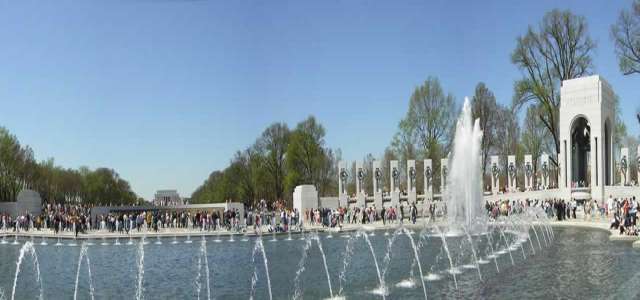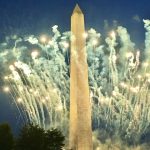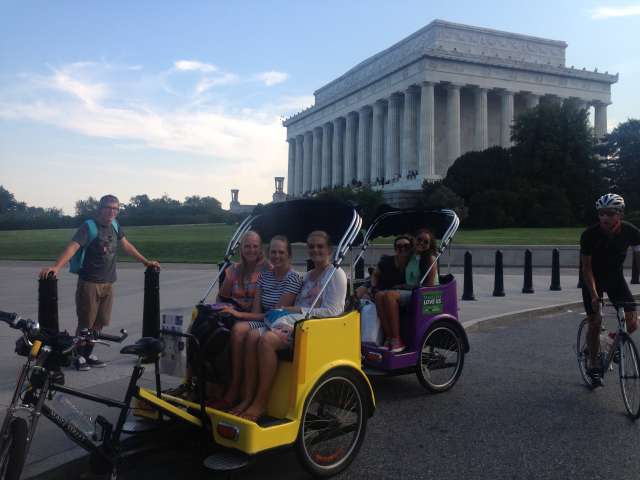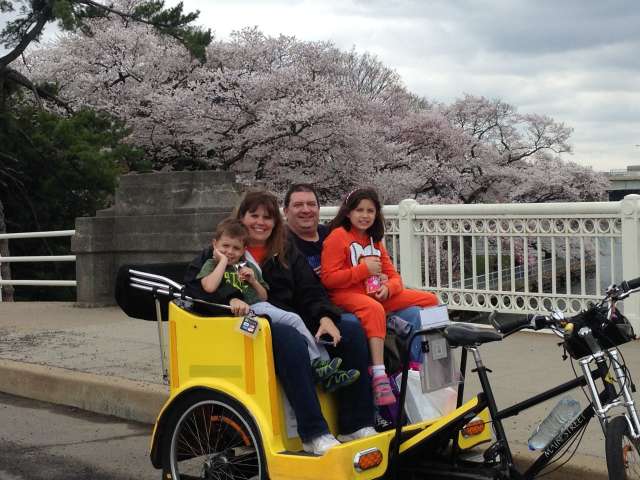Places to Visit in Washington DC — WWII Memorial
WWII Memorial — Among the Most Popular Places to Visit in Washington DC
The WWII Memorial is one of the most popular places to visit in Washington DC. The visitor can pay his/her respects to the sacrifices made by the USA in order to win the Second World War. Set halfway between the Washington Monument and the Lincoln Memorial, the WWII Memorial has magnificent views in every direction. This is one of the places to visit in Washington DC that cannot be missed. Nonpartisan Pedicab offers a DC tour that includes a visit to the WWII Memorial. The WWII Memorial is particularly impressive at night.
The WWII Memorial can be viewed every day of the year except July 4th. There is no access on July 4 due to its proximity to the fireworks. It is always free to the public.
WWII Memorial — Handicapped Services
The WWII Memorial is easily accessible to people with disabilities. The WWII Memorial sees a steady stream of aging World War II veterans. At the infromation kiosk near to the Memorial, there are free wheelchairs for any handicapped or elderly person to use. This service is available during working hours and is always free of charge. Handicapped parking is available on Home Front Drive, just outside of the WWII Memorial.
Getting to the WWII Memorial
The nearest Metro station is Smithsonian Metro, which is on the Orange/Blue/Silver lines. Be aware that the metro station is approximately a mile away from memorial. There is currently no Capitol Bikeshare stand here. The nearest Capitol Bikeshare stand is at the MLK Memorial. A great way to get here is to include the WWII Memorial in a pedicab tour of Washington DC attractions. Nonpartisan Pedicab gives an excellent tour of the DC monuments and the National Mall.
Parking at the WWII Memorial
Parking on the National Mall is always difficult. There is no regular parking at the WWII Memorial — only handicapped parking. Regular on street parking is a significant walk away. The nearest parking is in a metered public lot by the Tidal northeast corner of the Tidal Basin.
On-street parking on the National Mall is no longer free of charge. Three hour parking is available at $2 per hour. Parking meters only accept credit cards.
The WWII Memorial during the Cherry Blossom Festival
The WWII Memorial is very close to the Tidal Basin. The entire area around the Tidal Basin is lined with cherry trees. During late March or early April, they all come into bloom at once. The entire Tidal Basin area is a sea of pink and white. Full bloom only lasts a few days before the petals start to fall. The Cherry Blossom Festival attracts hundreds of thousands of visitors. The Japanese Lantern is across Independence Avenue from the WWII Memorial.
WWII Memorial — History and Facts
The World War II Memorial honors the service of sixteen million members of the Armed Forces of the United States of America, the support of countless millions on the home front, and the ultimate sacrifice of 405,399 Americans. On May 29, 2004, a four-day “grand reunion” of veterans on the National Mall culminated in the dedication of this tribute to the legacy of “The Greatest Generation.”
Granite, bronze, and water elements harmoniously blend with the lawns, trees, and shrubbery of the surrounding landscape. Here, the spirit of the L’Enfant Plan for the City of Washington lives on through successful integration of a memorial into the openness of the National Mall. Great vistas endure toward the Washington Monument, Thomas Jefferson Memorial, and Lincoln Memorial.
The twenty-four bronze bas-relief panels that flank the Ceremonial Entrance offer glimpses into the human experience at home and at war. They breathe new life into familiar black and white photographs or newsreels—especially, when a visiting veteran describes one of the scenes. The memorial also features areas where veterans’ recollections come flooding back, triggered by the sight of dozens of battle names and military campaign designations carved into stone. A wall of 4,048 Gold Stars silently pays solemn tribute to the sacrifice of more than 405,000 American lives.
Fifty-six granite columns, split between two half-circles framing the rebuilt Rainbow Pool with its celebratory fountains, symbolize the unprecedented wartime unity among the forty-eight states, seven federal territories, and the District of Columbia. Bronze ropes tie the columns together, while bronze oak and wheat wreathes respectively represent the nation’s industrial and agricultural strengths. Two 43-foot tall pavilions proclaim American victory on the Atlantic and Pacific fronts—on land, at sea, and in the air. Several hidden treasures appear as well, such as the famous “Kilroy was here” graffiti familiar to every veteran of the Second World War.
Visitors to the memorial are encouraged to search The World War II Registry, a computerized database honoring Americans who helped win the war, either overseas or on the home front. The National Park Service staff offers assistance to those wishing to update the list with additional names or information.
The National Park Service offers daily tours of the memorial every hour on the hour, from 10:00 a.m. until 11:00 p.m. In addition, Park Rangers offer several extended, in-depth walking and bicycle tours that include the World War II Memorial. The memorial is open daily from 9:00 a.m. until 11:45 p.m.; it is closed on December 25 and for annual events surrounding the National Independence Day Celebration.
More information can be found at the National Park Service website.







